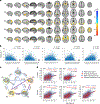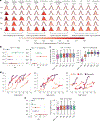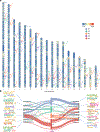Brain aging patterns in a large and diverse cohort of 49,482 individuals
- PMID: 39147830
- PMCID: PMC11483219
- DOI: 10.1038/s41591-024-03144-x
Brain aging patterns in a large and diverse cohort of 49,482 individuals
Abstract
Brain aging process is influenced by various lifestyle, environmental and genetic factors, as well as by age-related and often coexisting pathologies. Magnetic resonance imaging and artificial intelligence methods have been instrumental in understanding neuroanatomical changes that occur during aging. Large, diverse population studies enable identifying comprehensive and representative brain change patterns resulting from distinct but overlapping pathological and biological factors, revealing intersections and heterogeneity in affected brain regions and clinical phenotypes. Herein, we leverage a state-of-the-art deep-representation learning method, Surreal-GAN, and present methodological advances and extensive experimental results elucidating brain aging heterogeneity in a cohort of 49,482 individuals from 11 studies. Five dominant patterns of brain atrophy were identified and quantified for each individual by respective measures, R-indices. Their associations with biomedical, lifestyle and genetic factors provide insights into the etiology of observed variances, suggesting their potential as brain endophenotypes for genetic and lifestyle risks. Furthermore, baseline R-indices predict disease progression and mortality, capturing early changes as supplementary prognostic markers. These R-indices establish a dimensional approach to measuring aging trajectories and related brain changes. They hold promise for precise diagnostics, especially at preclinical stages, facilitating personalized patient management and targeted clinical trial recruitment based on specific brain endophenotypic expression and prognosis.
© 2024. The Author(s), under exclusive licence to Springer Nature America, Inc.
Conflict of interest statement
H.J.G. has received travel grants and speaker’s honoraria from Fresenius Medical Care, Neuraxpharm, Servier and Janssen Cilag as well as research funding from Fresenius Medical Care. R.T.S. received consulting income from Octave Bioscience and has received compensation for scientific reviewing from the American Medical Association. T.L.S.B. has received investigator-initiated research funding from the NIH, the Alzheimer’s Association, the Foundation at Barnes-Jewish Hospital, Siemens Healthineers and Avid Radiopharmaceuticals (a wholly owned subsidiary of Eli Lilly and Company). She participates as a site investigator in clinical trials sponsored by Eli Lilly and Company, Biogen, Eisai, Jaansen and Roche. She has served as a paid and unpaid consultant to Eisai, Siemens, Biogen, Janssen and Bristol-Myers Squibb. The other authors declare no competing interests.
Figures






References
-
- Tian YE et al. Heterogeneous aging across multiple organ systems and prediction of chronic disease and mortality. Nat. Med 29, 1221–1231 (2023). - PubMed
MeSH terms
Grants and funding
- R01 MH112847/MH/NIMH NIH HHS/United States
- HHSN271201600059C/DA/NIDA NIH HHS/United States
- S10 OD032285/OD/NIH HHS/United States
- R01 MH123550/MH/NIMH NIH HHS/United States
- R01 AG066650/AG/NIA NIH HHS/United States
- R01 AG067103/AG/NIA NIH HHS/United States
- R01 AG034161/AG/NIA NIH HHS/United States
- P30 AG066530/AG/NIA NIH HHS/United States
- RF1 AG054409/AG/NIA NIH HHS/United States
- P30 AG066546/AG/NIA NIH HHS/United States
- R01 AG058533/AG/NIA NIH HHS/United States
- R01 AG083865/AG/NIA NIH HHS/United States
- P30 AG072979/AG/NIA NIH HHS/United States
- ZIA AG000513/ImNIH/Intramural NIH HHS/United States
- U01 AG068057/AG/NIA NIH HHS/United States
- R01 AG085571/AG/NIA NIH HHS/United States
- P30 AG028747/AG/NIA NIH HHS/United States
- P01 AG003991/AG/NIA NIH HHS/United States
- U24 NS130411/NS/NINDS NIH HHS/United States
- P01 AG026276/AG/NIA NIH HHS/United States
- U19 AG033655/AG/NIA NIH HHS/United States
- U24 AG074855/AG/NIA NIH HHS/United States
- HHSN271201300284P/DA/NIDA NIH HHS/United States
- R01 AG054073/AG/NIA NIH HHS/United States
- R56 AG064088/AG/NIA NIH HHS/United States
- R01 AG080821/AG/NIA NIH HHS/United States

